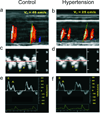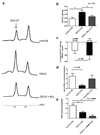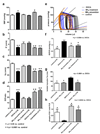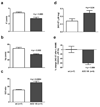Uncoupled cardiac nitric oxide synthase mediates diastolic dysfunction
- PMID: 20083682
- PMCID: PMC2819317
- DOI: 10.1161/CIRCULATIONAHA.109.883777
Uncoupled cardiac nitric oxide synthase mediates diastolic dysfunction
Abstract
Background: Heart failure with preserved ejection fraction is 1 consequence of hypertension and is caused by impaired cardiac diastolic relaxation. Nitric oxide (NO) is a known modulator of cardiac relaxation. Hypertension can lead to a reduction in vascular NO, in part because NO synthase (NOS) becomes uncoupled when oxidative depletion of its cofactor tetrahydrobiopterin (BH(4)) occurs. Similar events may occur in the heart that lead to uncoupled NOS and diastolic dysfunction.
Methods and results: In a hypertensive mouse model, diastolic dysfunction was accompanied by cardiac oxidation, a reduction in cardiac BH(4), and uncoupled NOS. Compared with sham-operated animals, male mice with unilateral nephrectomy, with subcutaneous implantation of a controlled-release deoxycorticosterone acetate pellet, and given 1% saline to drink were mildly hypertensive and had diastolic dysfunction in the absence of systolic dysfunction or cardiac hypertrophy. The hypertensive mouse hearts showed increased oxidized biopterins, NOS-dependent superoxide production, reduced NO production, and dephosphorylated phospholamban. Feeding hypertensive mice BH(4) (5 mg/d), but not treating with hydralazine or tetrahydroneopterin, improved cardiac BH(4) stores, phosphorylated phospholamban levels, and diastolic dysfunction. Isolated cardiomyocyte experiments revealed impaired relaxation that was normalized with short-term BH(4) treatment. Targeted cardiac overexpression of angiotensin-converting enzyme also resulted in cardiac oxidation, NOS uncoupling, and diastolic dysfunction in the absence of hypertension.
Conclusions: Cardiac oxidation, independently of vascular changes, can lead to uncoupled cardiac NOS and diastolic dysfunction. BH(4) may represent a possible treatment for diastolic dysfunction.
Figures





Comment in
-
NO way to relax: the complexities of coupling nitric oxide synthase pathways in the heart.Circulation. 2010 Feb 2;121(4):484-6. doi: 10.1161/CIR.0b013e3181d1e24e. Epub 2010 Jan 18. Circulation. 2010. PMID: 20083685 No abstract available.
-
Letter by Antoniades et al regarding article, "Uncoupled cardiac nitric oxide synthase mediates diastolic dysfunction".Circulation. 2010 Nov 23;122(21):e558; author reply e559. doi: 10.1161/CIRCULATIONAHA.110.952861. Circulation. 2010. PMID: 21098456 No abstract available.
References
-
- Schocken DD, Benjamin EJ, Fonarow GC, Krumholz HM, Levy D, Mensah GA, Narula J, Shor ES, Young JB, Hong Y. Prevention of heart failure: a scientific statement from the American Heart Association Councils on Epidemiology and Prevention, Clinical Cardiology, Cardiovascular Nursing, and High Blood Pressure Research; Quality of Care and Outcomes Research Interdisciplinary Working Group; and Functional Genomics and Translational Biology Interdisciplinary Working Group. Circulation. 2008;117:2544–2565. - PubMed
-
- Owan TE, Hodge DO, Herges RM, Jacobsen SJ, Roger VL, Redfield MM. Trends in prevalence and outcome of heart failure with preserved ejection fraction. N Engl J Med. 2006;355:251–259. - PubMed
-
- Ouzounian M, Lee DS, Liu PP. Diastolic heart failure: mechanisms and controversies. Nat Clin Pract Cardiovasc Med. 2008;5:375–386. - PubMed
-
- Redfield MM, Jacobsen SJ, Burnett JC, Jr, Mahoney DW, Bailey KR, Rodeheffer RJ. Burden of systolic and diastolic ventricular dysfunction in the community: appreciating the scope of the heart failure epidemic. JAMA. 2003;289:194–202. - PubMed
-
- Bursi F, Weston SA, Redfield MM, Jacobsen SJ, Pakhomov S, Nkomo VT, Meverden RA, Roger VL. Systolic and diastolic heart failure in the community. JAMA. 2006;296:2209–2216. - PubMed
Publication types
MeSH terms
Substances
Grants and funding
- R01 HL079032/HL/NHLBI NIH HHS/United States
- R01 HL085558/HL/NHLBI NIH HHS/United States
- R01 DK051445/DK/NIDDK NIH HHS/United States
- R01 DK39777/DK/NIDDK NIH HHS/United States
- F32 HL086232/HL/NHLBI NIH HHS/United States
- R01 HL79032/HL/NHLBI NIH HHS/United States
- 5 F32 HL086232-02/HL/NHLBI NIH HHS/United States
- R01 DK039777/DK/NIDDK NIH HHS/United States
- R01 HL085520/HL/NHLBI NIH HHS/United States
- R01 DK51445/DK/NIDDK NIH HHS/United States
- P01 HL058000/HL/NHLBI NIH HHS/United States
- R01 HL073753/HL/NHLBI NIH HHS/United States
LinkOut - more resources
Full Text Sources
Other Literature Sources
Medical

